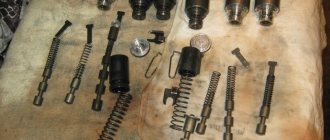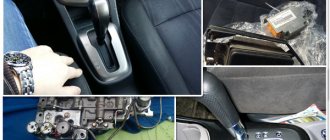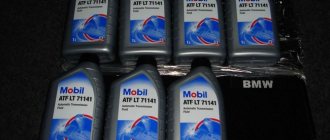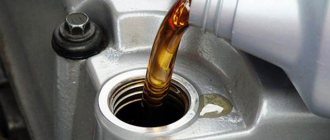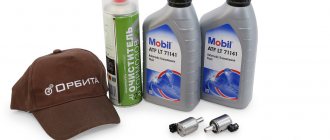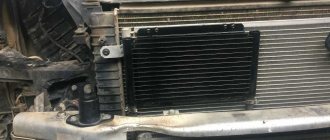Automatic transmission pump malfunctions
The oil pump is subjected to extreme loads during operation and therefore often fails. To prevent serious damage, it is necessary to follow the operating rules of the unit, monitor the pressure level and lubrication efficiency in the system.
Automatic transmission oil pump and its functions
Malfunctions of the automatic transmission oil pump are accompanied by a malfunction in the functioning of the car, the appearance of unnecessary sounds, jerking when driving, increased noise levels, slipping or a complete lack of movement. An oil pump is an eccentric gear pump that is connected to the crankshaft of a car engine. It is necessary to supply oil to the transmission under a certain pressure.
To ensure efficient operation of the automatic transmission, one of the well-known types of oil pumps is installed on it, with the help of which the required pressure in the system is maintained and lubrication efficiency is ensured when the engine picks up speed:
- cam;
- lobed;
- gear
A malfunction of the automatic transmission oil pump leads to an imbalance in the lubrication system, a change in the pressure level in it and a lack of the required pressure in the valve body.
Signs of a faulty oil pump in an automatic transmission
- transmission malfunctions;
- drop in oil pressure level in the system;
- slipping and disturbances in the dynamics of the vehicle;
- the appearance of a characteristic “howling” sound that changes its frequency and strength at the moment when the engine speed changes.
All this indicates a malfunction of the automatic transmission oil pump and the need to contact a service center to perform diagnostics. During inspection and examination of the automatic transmission, signs of pump failure are confirmed and the presence of malfunctions is detected.
When driving away from a parking spot, the driver may notice oil stains on the ground. This is one of the first and most obvious signs that the automatic transmission pump has failed. Particular attention should be paid to yellow and orange spots, indicating a malfunction of the automatic transmission pump.
To ensure uninterrupted operation of the automatic transmission, you must carefully monitor the condition of the automatic transmission oil pump, signs of malfunction of which are easy to notice. The driver should regularly check the oil level in the lubrication system using a dipstick, and after the control measurement, pay attention to the color and consistency of the oil.
Slipping, unnecessary sounds, jolts and jerks when starting to move may indicate that in a car with an automatic transmission there are signs of a breakdown of the first pump gear. Gears transfer oil from the suction channel to the discharge channel.
The efficiency of oil distribution throughout the system directly depends on their serviceability and the frequency of operation of the crankshaft.
Causes of malfunctions and repairs
The oil pump, the signs of malfunction of which are especially pronounced when the vehicle is operated in difficult conditions, can fail for several reasons:
- use of low-quality oil;
- mechanical damage to assembly parts;
- gear cracks;
- incorrect installation of automatic transmission;
- extreme driving.
The automatic transmission pump, signs of malfunction of which were noticed by the driver, must be thoroughly examined, the true cause must be found out and the breakdown repaired in a timely manner. This is best done in a car repair shop, under the control of modern equipment necessary for diagnosing problems. A malfunction of the automatic transmission pump, the symptoms of which were detected by the driver, can be eliminated in the service center as soon as possible. It is important, if you notice signs of a breakdown of the automatic transmission pump, to immediately seek help from a specialist.
Location
The oil pump in an automatic transmission is located inside the gearbox, so if problems arise with this element, it is necessary to dismantle the protective metal casing from the automatic transmission. In most cases, repair work does not require removing the transmission from the vehicle. However, in this case, you must take into account the design features of each specific vehicle and specific modifications of the automatic transmission. Only an experienced technician will be able to quickly determine the location of the oil pump and carry out all the necessary repair work as quickly as possible.
In order to understand the location of the oil pump, familiarize yourself with the automatic transmission structure as a whole.
The design and principle of operation of the oil pump - Video
More information about blocking GTR
So, why do we need this blocking? – It is a friction component of the GTR. At speeds above 60 km/h, when there is no need for direct operation of the torque converter, it turns on and connects the engine to the gearbox like a conventional dry clutch. In other words, the blocking is designed to increase the efficiency of the “donut”. If a torque converter with oil inside has an efficiency of about 70-80%, then with locking this figure already tends to 100% efficiency. Another thing! But for such a technical solution, as always, you have to pay something; Over time, the locking friction lining wears out and this is where problems begin. Let's talk about them.
Causes of automatic transmission pump breakdowns at an early stage
It's no secret that we sometimes blame the fact that we don't have time to stop at a service station. Although indirect reasons clearly indicate that there are problems with the hydraulics of our car. As a rule, the main reason for such breakdowns is our inattention and mediocre attitude towards the car. What else can cause an automatic transmission pump to break down in the first stages of car operation:
- Fast driving - excessive use of acceleration and braking can lead to rapid wear of transmission parts.
- Flexible disk - any problems in the operation of the unit where the torque converter is mounted to the engine.
- The installation of the transmission was carried out poorly and with violations; the size of the end gap was not maintained.
Oil leak
A popular problem with automatic transmissions is oil leaks at the seals. Therefore, it is advisable for the car owner to periodically visually inspect the box on a pit or lift. If you detect oil leaks on the gearbox, you need to contact a car repair shop. In this case, the problem is solved by simply replacing the gaskets and gear lubricant.
Read more: Rating of the cheapest cars on the Russian market
The service life and serviceability of the automatic transmission largely depends on the condition of the ATP fluid. Experts recommend replacing it every 40-50 thousand kilometers. However, timely replacement is not the key to long-term operation of the torque converter. In case of leaks and low levels of ATP fluid, the donut will fail very quickly.
How to make a quick diagnosis? You need to start the engine, open the hood and remove the automatic transmission oil dipstick. It has the inscription "Cold" or "NOTE" on it.
In the first case, it is not necessary to warm up the box. If the level is below normal, it urgently needs to be resumed. The liquid is poured through the same hole for the dipstick.
Pay attention to the condition of the oil itself. This way you can identify and prevent faults related to the torque converter in a timely manner. The presence of chips on the probe is excluded. If this is the case, it means that either the turbine or reactor wheel has failed, or the end washer has worn out.
Note! When operating an automatic transmission with a low level of ATP fluid, the gas turbine engine may overheat.
Periodically inspect the underbody of the car, namely the cover (pan) of the automatic transmission. Sometimes gaskets can leak. It is not advisable to operate a car with such a malfunction, since the oil level may drop at any time.
Blade blades
Metal blades, when exposed to high temperatures and the presence of abrasives in the transmission fluid, also wear out over time and add even more metal dust to the oil. Because of this, the efficiency of the torque converter decreases, the overall fluid pressure in the transmission system decreases, and because of the dirty fluid, the overheating of the system increases, the valve body wears out, and the load on the entire system increases. In the worst cases, one or more blades on the impeller may completely break.
Similar articles:
- Mask gearbox switching diagram. Maz gearbox operating principle. MAZ
- Basic automatic transmission malfunctions: signs, causes and methods for eliminating them
- The structure of a manual transmission of a car and decoding the manual transmission: a description of the operating principle for dummies, a gear shift diagram, photos and videos
- Starter malfunctions and ways to eliminate them; table of main symptoms and possible causes of failure; video on how to repair the device yourself
Correspondence of signs and causes
Here is a table of common automatic transmission breakdowns.
| Signs. | Causes. |
| Reverse gear does not work. Only speeds 1 and 2 function, but speeds 4 and 3 do not work. | The friction discs are worn out, the piston cuffs are broken, the sealing rings are destroyed. |
| The car does not move forward, it slips, reverse gear works. | Worn discs, front clutches, broken cuffs, worn clutch rings, stuck valve body. |
| The car does not move back and forth. Strong shocks when switching. | The torque converter is faulty; oil needs to be added and the filter needs to be replaced. |
| You can only drive in third gear. | Wear of friction discs, front clutches, breakage and wear of piston cups, wear of clutch rings, valve sticking. The electronic unit has switched the box into emergency mode; diagnostics and repairs are required. |
| Shifts on a cold box are made with jerks. | Dirty solenoids or hydraulic plates. Consumables need to be replaced and the valve body needs to be cleaned. |
| No reverse. | Worn brake band, broken cuffs, brake band, broken piston rod. |
| The car is unable to move in any direction. Switching is carried out without jolts. | Malfunction of the torque converter, pump drive gear, no gear engagement with the torque converter. It is necessary to add oil and clean the filter. Wear of the brake band, clutch and disc, as well as piston seals. Wear and breakage of O-rings. The valve body solenoid or valve is faulty. |
| The increasing rumble of the box, vibration when driving, intensify with increasing engine speed. | Bearing wear. |
| There is reverse gear, forward gears - only first and second. When the box warms up the problem goes away. | A dirty solenoid or valve body is stuck. |
| The car drives in neutral. | Incorrect adjustment of the gearbox lever or cable. Clutch piston jamming. Welding friction clutches. |
| Speeds are activated at high speeds. | Incorrect throttle cable adjustment, clogged filter, faulty throttle valve. |
| The car drives normally, but on an ascent the automatic transmission slips and switches to a reduced speed. | Low oil level, wear of friction discs, brake band. The oil pump and valve body solenoids are faulty. |
| A sudden press on the gas does not switch to a lower speed, and the kickdown does not work. | The button or sensor under the pedal is faulty, the switch valve is stuck, the damper cable is faulty, there is no power to the sensor. |
| When starting from a stop, it slips, but when the speed increases, it drives normally and the gearbox shifts properly. | Worn turbine wheel splines, broken cuffs. |
| When switching, slippage occurs. | The oil pump is faulty, the filter is clogged. |
| No forward or reverse. | The splines on the turbine wheel hub were cut off. |
| Significant shocks occur when changing speed. | Wear of the brake band, friction discs, clogged solenoids or valve body channels. |
| The car slips when driving and jerks when shifting. | Clutch failure. |
| No movement in both directions, no oil pressure. | Oil pump splines cut off. |
| The car moves normally until the oil warms up. Then slipping occurs and the car stops. | Faulty friction discs. When the oil is cold, its pressure and viscosity are higher compared to hot oil; worn discs are pressed better and form traction. Friction wear, oil contamination, filter mesh. |
| Noise in the form of metal beating at idle. | Severe wear on drum discs. |
| The transmission does not switch to a lower speed when the pedal is depressed, there is no kickdown. | Engine malfunction. |
| The transmission does not switch to a lower speed when the pedal is pressed all the way. The car moves normally until the oil warms up. Then the car slips and does not move. The car accelerates slowly. No reverse. | Violation of the tightness of the fan blades of the turbine and pump. Broken blades. |
| There are large metal shavings in the tray. | Severe wear on the planetary gear. |
| The oil in the box foams and slippage occurs. | Water penetration into automatic transmission. |
| Low oil pressure. | Dirty solenoids or valve body. It is necessary to check the oil level and the relief valve in the pump. |
| When the gear is engaged, the car stumbles and stalls. As the rpm increases it moves normally. | The speed clutch valve needs to be checked. The torque converter is faulty. |
| Aluminum shavings in a tray. | Wear of the plain bearing and planetary gear. |
| The tray contains plastic elements. | Broken plastic part. |
| Metal scraping. | Wear of differential bearing, gears. |
| Magnetized rollers were found in the automatic transmission tray. | Broken roller thrust bearing. |
Read more: Stability control system, dynamic stabilization system, ESP, VSA, VSC, VDC, DSC - purpose, device, principle of operation
Malfunctions of the automatic transmission torque converter lead to vibrations and unpleasant noises while driving the car in city mode, that is, at a speed of about 60 km/h. The causes of the malfunction may be partially failed friction pairs, wear of gear blades, destruction of sealing seals, or failure of bearings.
How to avoid problems with automatic transmission
Warm up the box regularly
A common problem with automatic gearboxes is mechanical wear of individual elements. There is only one solution to the problem - regularly warm up the box and let the working fluids fully lubricate all the parts.
Keep an eye on liquids
You need to monitor your mileage and change fluids on time. Read the vehicle manual; service recommendations may vary depending on the model. Check the oil level and quality every 5 thousand kilometers. Carry out diagnostics in the service.
Operate correctly
Higher speeds for an automatic transmission mean rapid wear and overheating - do not drive aggressively with such a transmission.
In winter, do not start driving immediately after starting the engine; let the box warm up.
Use the oil recommended by the manufacturer or car service center - we will talk about the principles of choosing oil and replacing it in a separate article.
Important. If you notice one or more signs of a malfunction, do not delay your trip to a car service center. Even basic problems with fluids or drives lead to increased wear on the movable parts of the box, which means the imminent death of the automatic transmission. A complete replacement of the box will definitely cost much more than repairs.
